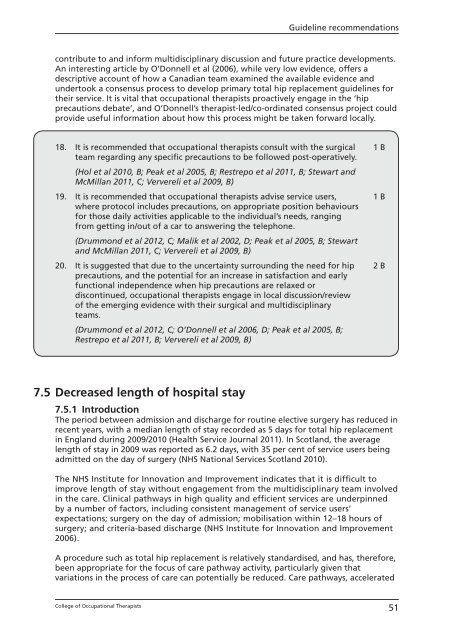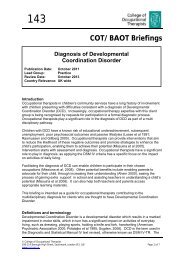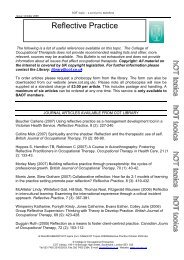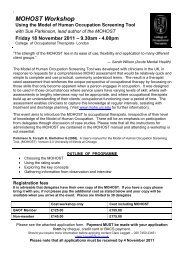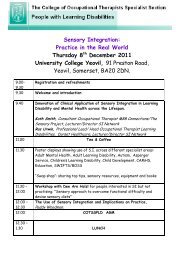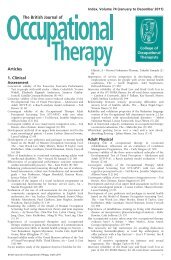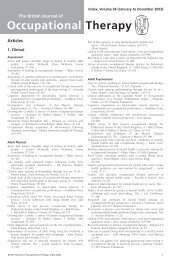Total hip replacement - College of Occupational Therapists
Total hip replacement - College of Occupational Therapists
Total hip replacement - College of Occupational Therapists
Create successful ePaper yourself
Turn your PDF publications into a flip-book with our unique Google optimized e-Paper software.
Guideline recommendations<br />
contribute to and inform multidisciplinary discussion and future practice developments.<br />
An interesting article by O’Donnell et al (2006), while very low evidence, <strong>of</strong>fers a<br />
descriptive account <strong>of</strong> how a Canadian team examined the available evidence and<br />
undertook a consensus process to develop primary total <strong>hip</strong> <strong>replacement</strong> guidelines for<br />
their service. It is vital that occupational therapists proactively engage in the ‘<strong>hip</strong><br />
precautions debate’, and O’Donnell’s therapist- led/co-ordinated consensus project could<br />
provide useful information about how this process might be taken forward locally.<br />
18. It is recommended that occupational therapists consult with the surgical<br />
team regarding any specific precautions to be followed post- operatively.<br />
(Hol et al 2010, B; Peak et al 2005, B; Restrepo et al 2011, B; Stewart and<br />
McMillan 2011, C; Ververeli et al 2009, B)<br />
19. It is recommended that occupational therapists advise service users,<br />
where protocol includes precautions, on appropriate position behaviours<br />
for those daily activities applicable to the individual’s needs, ranging<br />
from getting in/out <strong>of</strong> a car to answering the telephone.<br />
(Drummond et al 2012, C; Malik et al 2002, D; Peak et al 2005, B; Stewart<br />
and McMillan 2011, C; Ververeli et al 2009, B)<br />
20. It is suggested that due to the uncertainty surrounding the need for <strong>hip</strong><br />
precautions, and the potential for an increase in satisfaction and early<br />
functional independence when <strong>hip</strong> precautions are relaxed or<br />
discontinued, occupational therapists engage in local discussion/review<br />
<strong>of</strong> the emerging evidence with their surgical and multidisciplinary<br />
teams.<br />
(Drummond et al 2012, C; O’Donnell et al 2006, D; Peak et al 2005, B;<br />
Restrepo et al 2011, B; Ververeli et al 2009, B)<br />
1 B<br />
1 B<br />
2 B<br />
7.5 Decreased length <strong>of</strong> hospital stay<br />
7.5.1 Introduction<br />
The period between admission and discharge for routine elective surgery has reduced in<br />
recent years, with a median length <strong>of</strong> stay recorded as 5 days for total <strong>hip</strong> <strong>replacement</strong><br />
in England during 2009/2010 (Health Service Journal 2011). In Scotland, the average<br />
length <strong>of</strong> stay in 2009 was reported as 6.2 days, with 35 per cent <strong>of</strong> service users being<br />
admitted on the day <strong>of</strong> surgery (NHS National Services Scotland 2010).<br />
The NHS Institute for Innovation and Improvement indicates that it is difficult to<br />
improve length <strong>of</strong> stay without engagement from the multidisciplinary team involved<br />
in the care. Clinical pathways in high quality and efficient services are underpinned<br />
by a number <strong>of</strong> factors, including consistent management <strong>of</strong> service users’<br />
expectations; surgery on the day <strong>of</strong> admission; mobilisation within 12–18 hours <strong>of</strong><br />
surgery; and criteria- based discharge (NHS Institute for Innovation and Improvement<br />
2006).<br />
A procedure such as total <strong>hip</strong> <strong>replacement</strong> is relatively standardised, and has, therefore,<br />
been appropriate for the focus <strong>of</strong> care pathway activity, particularly given that<br />
variations in the process <strong>of</strong> care can potentially be reduced. Care pathways, accelerated<br />
<strong>College</strong> <strong>of</strong> <strong>Occupational</strong> <strong>Therapists</strong><br />
51


